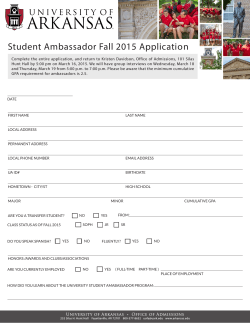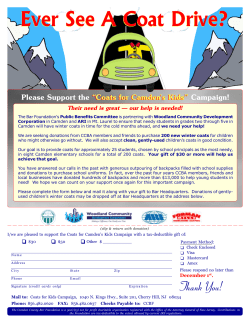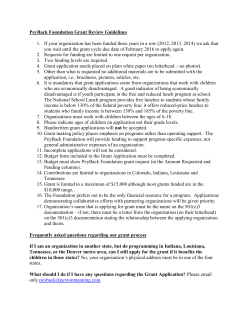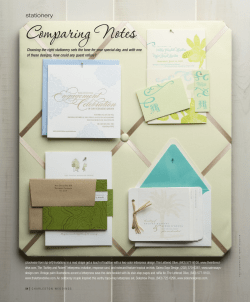
YOUNG ‘SCIENCE AMBASSADORS’ change raise the profile of science Katie Ridley
leading change Figure 1 Photocall for our school science ambassadors! YOUNG ‘SCIENCE AMBASSADORS’ raise the profile of science Katie Ridley appointed children as ‘science ambassadors’ and raised the profile of science across her school Key words: Types of activity Ownership Creativity 14 T he inspiration for ‘science ambassadors’ came to me after embarking on the Primary Science Quality Mark programme (www.psqm.org. uk). The initial interviews with the children started me thinking about their perception of science. Many claimed that they did not do science very often, but examining written work and displays around the school and talking to other teachers place and to understand that science was not all about making a mess or using a stopwatch! This seemed a huge undertaking and as I continued on my PSQM journey, it became apparent that this was something not to be done alone. The whole process was about working as a school to raise the profile of suggested that this was definitely science. I had initially worked not the case. I realised that on getting the teachers to help. science was just not recognised as We had written our own set of such by the children. They talked about scientific experiments they science principles, agreed what a ‘good’ science lesson looked like had done but did not mention and that a scientific investigation topics they had covered such as would happen within each topic. ‘teeth’, ‘light and shadows’ and While all of these things would ‘adaptation’. I knew then that I certainly help, I felt it was also needed to do something to raise important to involve the children the profile of science across the more in the running of science school. I needed the children to know when science was taking across the school. Primary Science 133 May/June 2014 leading change the interviews the children had already expressed the view that science only happened when they I came up with the idea of were doing experiments and I did science ambassadors as I thought not want to reinforce that belief. that it would create a soughtHowever, the presence of the after role within the school. ambassadors in their lab coats has Children who were selected provided a real signal to the class would receive a clipboard and that the lesson they are doing a white lab coat, complete with is ‘science’. Some children have school logo and the title ‘science been quite surprised to learn that ambassador’. The lab coats areas such as ‘teeth’, ‘plants’ and were to be worn by the children ‘habitats’ are all ‘science’ (Figure whenever a science lesson was 2). It seems that they did have a taking place and they were to stereotypical view that science gather evidence (a science skill!) was ‘doing experiments’! Now, to be able to report on science when I ask, children tell me that activities in the school in termly they do ‘loads of science’. I don’t meetings with me. I knew that all think that the quantity of science these features would appeal to the lessons has increased over the children and would give the role year, but the children are more of the ambassador a high status Appointing the science ambassadors Figure 2 When are we doing science? across the school (Figure 1). To introduce the science ambassadors we held a special assembly, all about science and the ways in which science influences our everyday lives. The ambassadors were called to the front to receive their clipboards and white lab coats. Two children from each class, from reception (ages 4–5) to year 6 (ages 10–11), were selected to take on the role. These children were chosen because they had shown an interest in science and were good role models within the class. They immediately felt very special: ‘I feel like a real scientist’ said 5-year-old Scarlett. Initially I was hesitant about dressing the science ambassadors in white lab coats as I felt this was a little too stereotypical. In the children talking to each other about what they have done and sharing the joy and excitement that good science lessons bring. As a science coordinator, this has given me an invaluable insight into, and understanding of, the science teaching that is taking place across the school. I feel that if a child did not have anything to report to me on a termly basis, then I would be able to speak to the class teacher to find out why this was the case. It hasn’t happened yet. The photographs that the children take have formed a great portfolio of science across the school and this has saved me the termly job of asking teachers for photographs of science, waiting to receive them and then collating them all (usually late one evening!) into a portfolio. aware when they are involved in a science activity. The ambassadors love wearing their lab coats in the science lesson and feel a great sense of pride and importance as they know that they will have to report back on whatever science activity is taking place. Expanding the role – lab technicians More recently, I have involved the year 5 and 6 (ages 9–11) ambassadors in the organisation of our science resources. They helped me to sort out and label the science area and have become responsible for assisting teachers The science ambassadors’ in setting up the classroom for role science investigations (Figure The science ambassadors wear 3). This additional support has their lab coats whenever science is really helped the teachers in their taking place. They have a special lesson preparation and some report card to complete, detailing have commented that they are the lesson and identifying doing more science investigations learning that has taken place. The because ‘they are easier to set up’, younger children can record by so removing one of the barriers to taking photographs and, at our practical science. science ambassador meetings, Science week they all discuss what learning is The science ambassadors were taking place. also a great asset during science It has been lovely to witness Primary Science 133 May/June 2014 15 leading change Figure 3 Our junior ‘lab technicians’ have enjoyed their role and proved very helpful Figure 4 The science ambassadors proudly displaying some of the school’s work in Science Week week. They were consulted about the types of science that they wanted to see being done, the visitors they would like to invite, and where they would like to go. Finally, they were involved in helping me to display all of our work (Figure 4). They wore their lab coats all week and visitors to the school recognised that these were ‘special’ children and asked them to explain their role. The children loved all this extra attention and were very keen and proud to discuss their role. The future … New ambassadors have been selected for this academic year. It was lovely to see how keen all the children were to be given the role. This gave me the assurance that the role is highly desirable and sought after within the school. I would like to use the ambassadors to develop the science section of our school website. I am going to use the termly meetings to teach the children how to upload photographs and create weblinks. Further to this, I hope to teach the ambassadors to use the school’s tablet computers to create videos of specific science topics. My plan is to upload these to the school website and give each video a QR code that can be stuck into children’s books so that parents or visitors to the school will be able to watch the children enjoying science lessons. I am incredibly proud of the science ambassadors and I believe that they have made a very positive contribution to helping me raise the profile of science across our school. I am even more thrilled that it is the children who have made this happen. Katie Ridley is science coordinator at St Gregory’s Catholic Primary School, Liverpool. Email: katie. ridley@yahoo.co.uk One Small Step fOr Science One Giant leap fOr Science learninG! The What on Earth? Wallbook of Science and Engineering is being published on 1st July 2013. this unique historical timeline features more than 1,000 of the most extraordinary moments in the story of science, engineering and inventions from the Stone ages to the present day. Beautifully drawn and packed with fascinating facts and details, the Wallbook can be read like a book or unfolded into a giant 2.3m long timeline – perfect for science classrooms and curious minds. the association for Science education is proud to offer readers of primary Science a special introductory price of £14 (rrp £17.50) for orders made by the end of July. Buy online now (payment by purchase order accepted) at www.whatonearthbooks.com/science Produced under licence from SCMG Enterprises Ltd. Science Museum ® SCMG. Every purchase supports the museum. www.sciencemuseum.org.uk 16 Primary Science 133 May/June 2014
© Copyright 2025



















